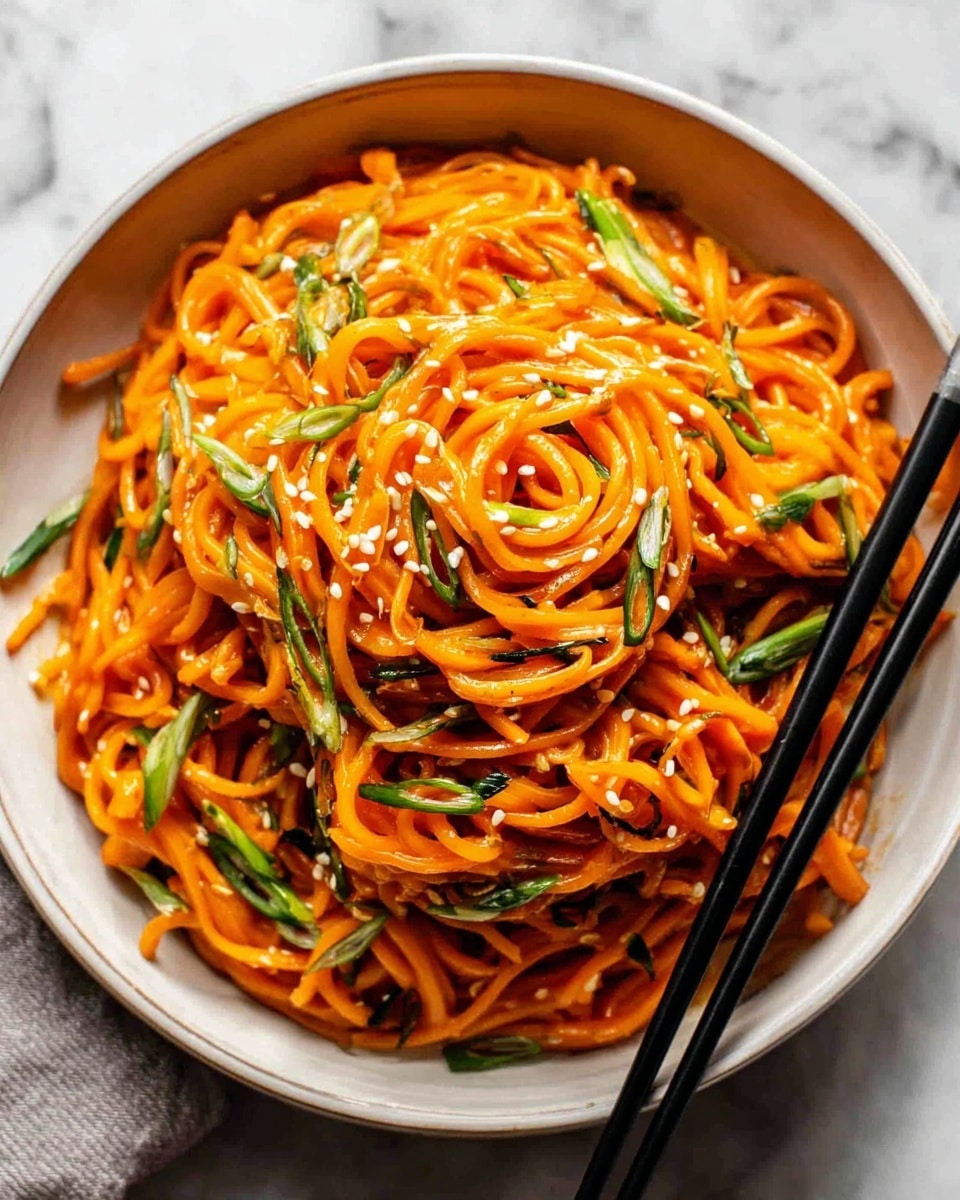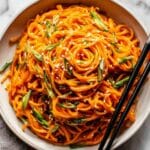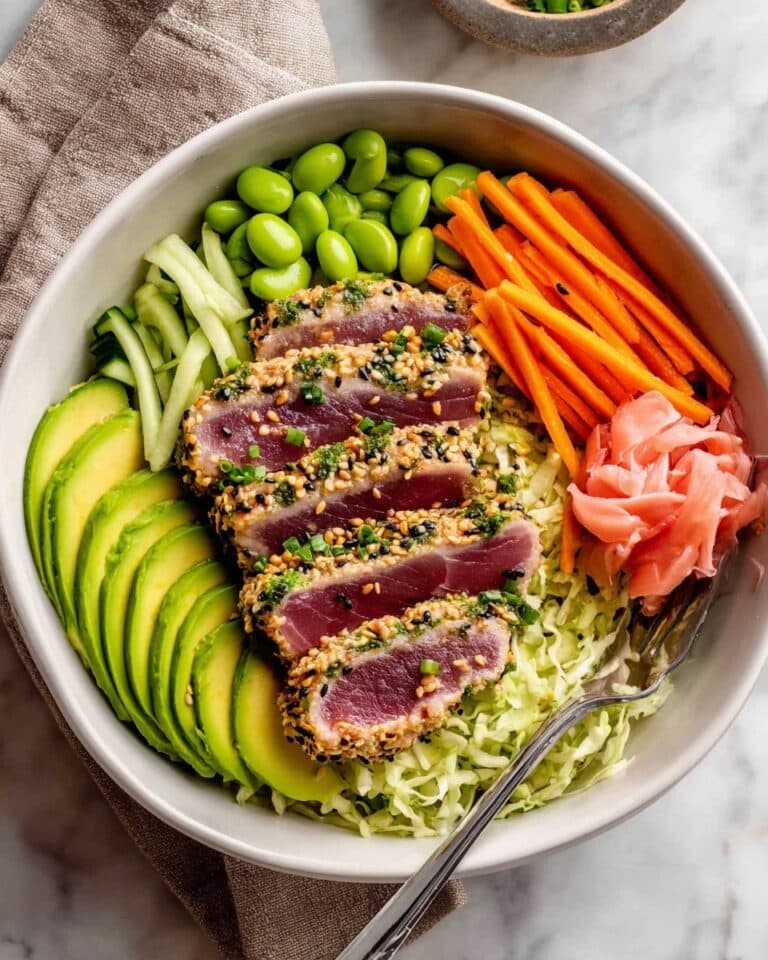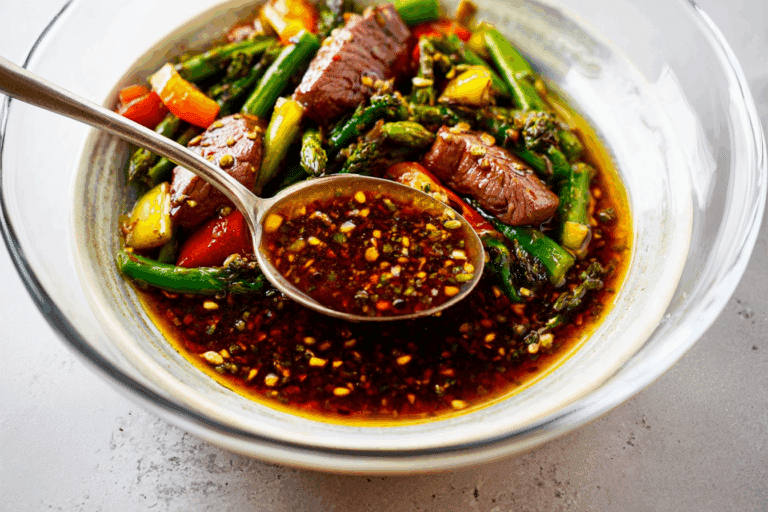Saucy Gochujang Zucchini Noodles Recipe
Oh, you’re going to love this Saucy Gochujang Zucchini Noodles Recipe—it’s one of those dishes that feels both fresh and totally satisfying. The zingy, spicy gochujang sauce coats tender zucchini noodles in a way that’s just downright addictive. I often reach for this recipe when I want something light but packed with flavor, especially after a heavy weekend or when I crave Korean-inspired comfort food without the heaviness of traditional noodles.
What makes this saucy gochujang zucchini noodles recipe stand out is how easy and quick it comes together. Plus, it’s incredibly versatile—you can dress it up with proteins or keep it delightfully simple for a fast, healthy meal. The balance of tangy lime, savory hoisin, and the subtle heat from gochujang keeps me coming back, and I promise you’ll appreciate that unique flavor combo too!
Ingredients You’ll Need
Each ingredient here plays a role in creating that harmony of flavors and textures. I like to use fresh produce and authentic pantry staples for the best flavor punch—especially the gochujang and good-quality rice noodles. Here’s a quick rundown with some tips to keep your kitchen prep smooth.
- Zucchini: Spiralized fresh zucchini is the star here—look for firm, medium-sized ones that aren’t too watery to avoid soggy noodles.
- Kosher salt: A little salt draws out moisture from zucchini, preventing the dish from becoming watery.
- Gochujang: This Korean chili paste adds spicy, sweet, and umami goodness—be sure to get one labeled “fermented” for authentic depth.
- Hoisin sauce: Adds a rich, slightly sweet contrast that complements the heat of gochujang beautifully.
- Fresh lime juice: Brightens the sauce with citrus tang—fresh is best, not bottled.
- Olive oil: For richness and to help everything meld together; you can substitute with sesame oil if you want a nuttier flavor.
- Minced fresh garlic: Garlic brings that irresistible punch—don’t skip it!
- Rice noodles: Cook according to package directions; I prefer thin rice noodles that soak up the sauce well without overpowering the zucchini.
- Cornstarch: Helps thicken the sauce slightly, giving it that luscious cling to each noodle.
- Unsalted butter: Adds silkiness and richness; vegan butter is a great swap for plant-based diets.
- Toasted sesame oil: Just a splash at the end amps up the aroma and all those Asian flavors.
- Sliced scallions and sesame seeds (optional): Perfect finishing touches for crunch and extra flavor.
Variations
I love mixing things up with this saucy gochujang zucchini noodles recipe depending on what’s in my fridge or my mood. Feel free to experiment—you might find a new favorite twist!
- Add protein: Toss in grilled chicken, shrimp, or tofu for a more filling meal. I once cooked up some spicy shrimp to pair with it and it was a total hit for dinner guests.
- Make it vegan: Just swap the butter for vegan butter and double-check the hoisin sauce for any animal ingredients.
- Use different veggies: Spiralize carrots or sweet potatoes for extra color and sweetness—great for seasonal versions.
- Turn up the heat: If you like it extra spicy, add some crushed red pepper flakes or a drizzle of chili oil.
- Noodle swap: If you’re not into zucchini, this sauce goes wonderfully with whole wheat spaghetti or soba noodles.
How to Make Saucy Gochujang Zucchini Noodles Recipe
Step 1: Spiralize and Salt the Zucchini
Start by spiralizing your zucchinis into noodle shapes—you can use a spiralizer or a julienne peeler if you’re feeling fancy. Sprinkle the zucchini noodles with kosher salt and let them sit for about 10 minutes. This step helps pull out excess moisture, which means your noodles won’t get soggy once you toss them with the sauce. After resting, gently squeeze the noodles in a clean kitchen towel or paper towel to remove any extra liquid.
Step 2: Prepare the Rice Noodles
While the zucchini rests, cook your rice noodles according to the package directions. Rinse them under cold water right after cooking to stop the cooking process and prevent sticking. Drain well and set aside. Trust me, proper draining here keeps everything from turning into a mushy mess later on.
Step 3: Mix the Sauce
Whisk together the gochujang, hoisin sauce, fresh lime juice, olive oil, and minced garlic in a bowl. This saucy gochujang zucchini noodles recipe’s magic lies in this balanced sauce—it’s sweet, spicy, tangy, and perfect for coating those noodles evenly.
Step 4: Thicken and Cook
In a pan over medium heat, melt the butter and add the cornstarch to create a slurry. Slowly whisk in your gochujang sauce mixture into the butter and cornstarch, stirring constantly until it thickens slightly and becomes glossy. This step is crucial to get that silky texture that clings to every strand.
Step 5: Combine All the Noodles
Turn down the heat and toss in both the spiralized zucchini and the cooked rice noodles directly into your sauce. Stir gently and let everything warm through for about 2-3 minutes—just enough to soften the zucchini a bit without losing its crunch. Finish by drizzling toasted sesame oil over the top and giving it one last stir.
How to Serve Saucy Gochujang Zucchini Noodles Recipe
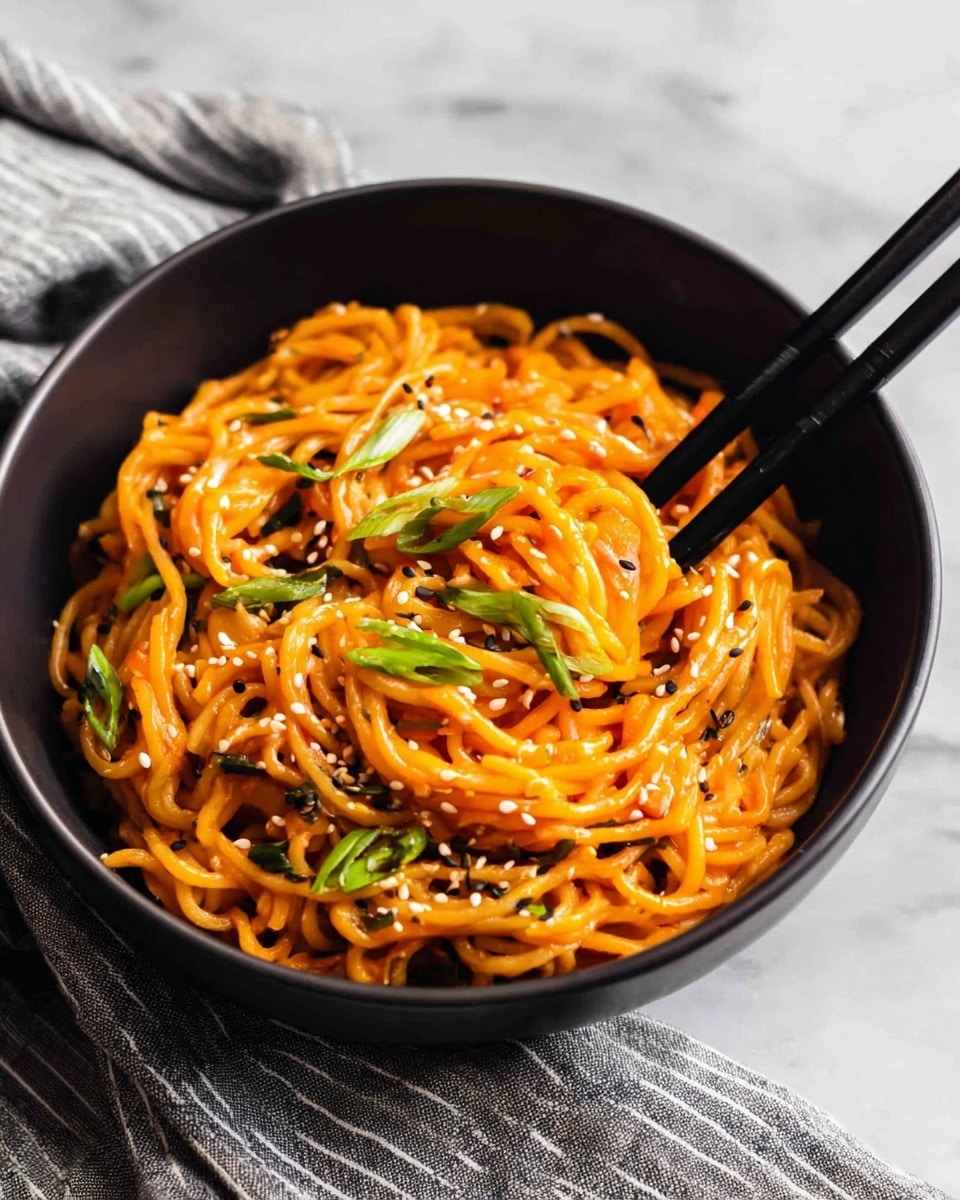
Garnishes
I always top this dish with plenty of sliced scallions and a sprinkle of toasted sesame seeds—they add such a fresh crunch and nutty flavor that I find totally elevates the whole meal. Sometimes, I’ll even add a handful of chopped roasted peanuts or fresh cilantro for a bit more texture and herbaceous brightness.
Side Dishes
For sides, I like something light and crisp like a simple cucumber salad or quick kimchi for that spicy fermented kick. This saucy gochujang zucchini noodles recipe also pairs beautifully with steamed edamame or even grilled marinated tofu if you want to keep it plant-based but protein-rich.
Creative Ways to Present
I once served these noodles in individual bamboo steamers for a guests’ dinner party—so fun and unexpected! They also make a great base for a noodle bowl, topped with sliced avocado, soft-boiled eggs, and crunchy radishes, which turns this simple recipe into a stunning, colorful meal perfect for sharing.
Make Ahead and Storage
Storing Leftovers
Leftovers are best stored in an airtight container in the fridge and eaten within 2 days to keep the zucchini noodles from becoming too mushy. I usually keep the sauce separate if I plan ahead and toss everything together just before reheating to preserve the noodles’ texture.
Freezing
I don’t recommend freezing this saucy gochujang zucchini noodles recipe because zucchini noodles don’t hold up well after freezing—the texture gets a bit watery and limp. If you want to freeze, it’s better to freeze the sauce alone and prepare fresh noodles when you’re ready.
Reheating
To reheat, warm it gently in a skillet over low-medium heat just until heated through. Avoid microwaving as it tends to make the zucchini watery. Adding a splash of water or lime juice during reheating helps freshen the noodles back up.
FAQs
-
Can I use regular pasta instead of rice noodles in this Saucy Gochujang Zucchini Noodles Recipe?
Absolutely! While rice noodles keep with the Asian flavors, you can swap in regular spaghetti, soba, or even whole wheat pasta depending on your preference or what you have on hand. Just cook and drain them as usual, then mix with the sauce and zucchini noodles for that saucy goodness.
-
How spicy is this Saucy Gochujang Zucchini Noodles Recipe?
Gochujang has a moderate heat level that’s balanced with sweetness and umami, making this recipe gently spicy rather than fiery hot. If you want more kick, you can always add extra gochujang or a pinch of chili flakes according to your heat tolerance.
-
Can I make this recipe vegan?
Definitely! Swap out unsalted butter for vegan margarine or coconut oil, and verify your hoisin sauce is vegan-friendly—many are, but it’s always good to check. The rest of the ingredients are naturally plant-based.
-
What’s the best way to avoid watery zucchini noodles?
Salting and resting the spiralized zucchini to release moisture, then squeezing the excess liquid out before adding to your sauce is key. Also, avoid cooking them too long—you want tender but still slightly crisp noodles for the best texture.
-
Can I prepare the sauce ahead of time?
Yes, the sauce can be mixed and stored in the fridge for up to 3 days. Just give it a good whisk before using, and make sure to make the slurry fresh when cooking to maintain that glossy, thick texture.
Final Thoughts
This Saucy Gochujang Zucchini Noodles Recipe has become a kitchen favorite whenever I want something quick, healthy, and packed with flavor. It’s refreshing yet saucy enough to satisfy those noodle cravings without the heaviness. I’m excited for you to try it out—you might just find it’s your new go-to weeknight recipe! Seriously, once you get comfortable with the sauce balance, this dish is endlessly adaptable and always tasty.
PrintSaucy Gochujang Zucchini Noodles Recipe
This easy and flavorful Saucy Gochujang Noodles recipe combines spiralized zucchini and rice noodles tossed in a tangy and spicy gochujang-based sauce. With its vibrant Korean-inspired flavors and quick preparation, it’s a perfect light yet satisfying meal for any day of the week.
- Prep Time: 10 minutes
- Cook Time: 10 minutes
- Total Time: 20 minutes
- Yield: 4 servings
- Category: Main Course
- Method: Stovetop
- Cuisine: Korean
- Diet: Vegetarian
Ingredients
Vegetables and Noodles
- 3 large zucchini, spiralized
- 8 ounces rice noodles, cooked according to package directions; drained
- Sliced scallions and sesame seeds for serving (optional)
Sauce Ingredients
- 1 teaspoon kosher salt
- ¼ cup gochujang
- 3 tablespoons hoisin sauce
- 3 tablespoons fresh lime juice
- 3 tablespoons olive oil
- 1 teaspoon minced fresh garlic
- 1 tablespoon cornstarch
Cooking Fats
- 2 tablespoons unsalted butter (vegan butter if needed)
- 1 tablespoon toasted sesame oil
Instructions
- Prepare Zucchini: Spiralize the 3 large zucchinis into noodles and sprinkle with 1 teaspoon kosher salt. Set aside to allow them to release some moisture.
- Cook Rice Noodles: Cook 8 ounces of rice noodles according to the package instructions. Drain and set aside.
- Mix Sauce: In a bowl, combine ¼ cup gochujang, 3 tablespoons hoisin sauce, 3 tablespoons fresh lime juice, 3 tablespoons olive oil, and 1 teaspoon minced fresh garlic. Whisk them together until smooth and well incorporated.
- Thicken Sauce: Dissolve 1 tablespoon cornstarch in a small amount of water to create a slurry. Add this to the sauce mixture to help thicken it once heated.
- Cook Sauce: In a skillet or pan over medium heat, melt 2 tablespoons of unsalted butter (or vegan butter if preferred). Add the sauce mixture and cook, stirring frequently, until the sauce thickens and becomes glossy, about 3-5 minutes.
- Toss Noodles: Add the spiralized zucchini noodles and cooked rice noodles into the skillet with the sauce. Gently toss to coat the noodles evenly without breaking the noodles apart.
- Finish with Sesame Oil: Drizzle 1 tablespoon of toasted sesame oil over the noodles and toss once more to incorporate the nutty flavor.
- Serve: Transfer the noodles to serving plates and garnish with sliced scallions and sesame seeds if desired. Serve warm for the best taste and texture.
Notes
- The spiralized zucchini helps keep the dish light and adds a wonderful fresh crunch.
- Adjust gochujang amount according to your preferred spice level.
- Ensure not to overcook the zucchini noodles, as they can become soggy quickly.
- Hoisin sauce adds sweetness, but you may substitute with a gluten-free option if needed.
- For a vegan version, use vegan butter and confirm that your gochujang contains no animal products.

